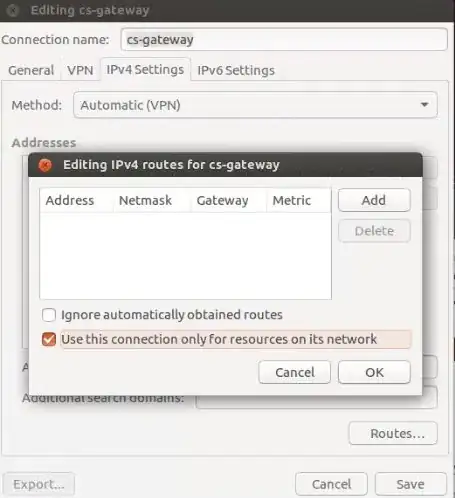Summary: I'd like to connect to my VPN and have access to certain servers, but for all other traffic I'd like to use my regular networking.
I've setup an OpenVPN server on my VPS, my server.conf file looks like so:
port 1194
proto udp
dev tun
ca ca.crt
cert server.crt
key server.key # This file should be kept secret
dh dh2048.pem
server 10.8.0.0 255.255.255.0
ifconfig-pool-persist ipp.txt
keepalive 10 120
comp-lzo
user nobody
group nogroup
persist-key
persist-tun
status openvpn-status.log
log /var/log/openvpn.log
verb 4
push "route 10.132.0.0 255.255.0.0"
I use the following .ovpn file to setup the VPN Connection:
client
dev tun
proto udp
remote <my.vpn.server.com> 1194
nobind
user nobody
group nogroup
persist-key
persist-tun
remote-cert-tls server
comp-lzo
verb 3
<ca>....</ca>
<cert>...</cert>
<key>...</key>
Finally, in the Network Manager for the VPN Connection, under IPv4 Settings I have made sure to set the "Method" to "Automatic (VPN) addresses only".
VPN connects fine, I can access all the internal servers I need (10.132.x.x), however I cannot access anything else (like google.com). I'd like my eth0 settings to be used for everything except for the 10.132.x.x IPs which I would like routed through the VPN.
P.S. based on other articles I've tried using no-pull in the .ovpn file and adding in my route settings there but to no avail.
EDIT 1:
Results of running ip a and traceroute while connected to VPN:
$ ip a
1: lo: <LOOPBACK,UP,LOWER_UP> mtu 65536 qdisc noqueue state UNKNOWN group default qlen 1
link/loopback 00:00:00:00:00:00 brd 00:00:00:00:00:00
inet 127.0.0.1/8 scope host lo
valid_lft forever preferred_lft forever
inet6 ::1/128 scope host
valid_lft forever preferred_lft forever
2: eth0: <BROADCAST,MULTICAST,UP,LOWER_UP> mtu 1500 qdisc pfifo_fast state UP group default qlen 1000
link/ether 08:00:27:dc:a6:ef brd ff:ff:ff:ff:ff:ff
inet 10.0.2.15/24 brd 10.0.2.255 scope global dynamic eth0
valid_lft 86320sec preferred_lft 86320sec
inet6 fe80::f3d1:6eb3:e13e:d61b/64 scope link
valid_lft forever preferred_lft forever
15: tun0: <POINTOPOINT,MULTICAST,NOARP,UP,LOWER_UP> mtu 1500 qdisc pfifo_fast state UNKNOWN group default qlen 100
link/none
inet 10.8.0.6 peer 10.8.0.5/32 brd 10.8.0.6 scope global tun0
valid_lft forever preferred_lft forever
$ traceroute google.com
google.com: Temporary failure in name resolution
Cannot handle "host" cmdline arg `google.com' on position 1 (argc 1)
EDIT 2: results of ip r
$ ip r
default via 10.8.0.5 dev tun0 proto static metric 50
default via 10.0.2.2 dev eth0 proto static metric 100
10.0.2.0/24 dev eth0 proto kernel scope link src 10.0.2.15 metric 100
10.8.0.1 via 10.8.0.5 dev tun0 proto static metric 50
10.8.0.5 dev tun0 proto kernel scope link src 10.8.0.6 metric 50
10.132.0.0/16 via 10.8.0.5 dev tun0 proto static metric 50
104.236.239.153 via 10.0.2.2 dev eth0 proto static metric 100
169.254.0.0/16 dev eth0 scope link metric 1000
